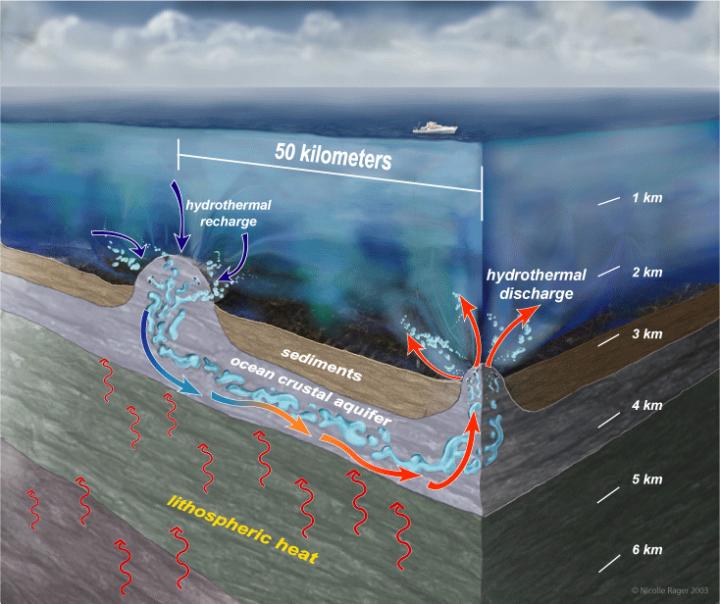A 'hydrothermal siphon' drives water circulation through the seafloor

Studies by Andrew Fisher and colleagues have shown that seamounts provide conduits through which enormous quantities of water flow between the ocean and the rocks beneath the seafloor. Courtesy of Nicolle Rager
Vast quantities of ocean water circulate through the seafloor, flowing through the volcanic rock of the upper oceanic crust. A new study by scientists at UC Santa Cruz, published June 26 in Nature Communications, explains what drives this global process and how the flow is sustained.
About 25 percent of the heat that flows out of the Earth's interior is transferred to the oceans through this process, according to Andrew Fisher, professor of Earth and planetary sciences at UC Santa Cruz and coauthor of the study. Much of the fluid flow and heat transfer occurs through thousands of extinct underwater volcanoes (called seamounts) and other locations where porous volcanic rock is exposed at the seafloor.
Fisher led an international team of scientists that in the early 2000s discovered the first field site where this process could be tracked from fluid inflow to outflow, in the northeastern Pacific Ocean. In a 2003 paper published in Nature, Fisher and others reported that bottom seawater entered into one seamount, traveled horizontally through the crust, gaining heat and reacting with crustal rocks, then discharged into the ocean through another seamount more than 50 kilometers away.
'Ever since we discovered a place where these processes occur, we have been trying to understand what drives the fluid flow, what it looks like, and what determines the flow direction,' Fisher said.
For the new study, first author Dustin Winslow, a UCSC Ph.D. candidate who graduated this month, developed the first three-dimensional computer models showing how the process works. The models reveal a 'hydrothermal siphon' driven by heat loss from deep in the Earth and the flow of cold seawater down into the crust and of warmed water up out of the crust.
'Dustin's models provide the best, most realistic view of these systems to date, opening a window into a hidden realm of water, rock, and life,' Fisher said.
The models show that water tends to enter the crust ('recharge') through seamounts where fluid flow is easiest due to favorable rock properties and larger seamount size. Water tends to discharge where fluid flow is more difficult due to less favorable rock properties or smaller seamount size. This finding is consistent with field observations suggesting that smaller seamounts are favored as sites of hydrothermal discharge.
'This modeling result was surprising initially, and we had to run many simulations to convince ourselves that it made sense,' Winslow said. 'We also found that models set up to flow in the opposite direction would spontaneously flip so that discharge occurred through less transmissive seamounts. This seems to be fundamental to explaining how these systems are sustained.'
Winslow's project was funded by the U.S. National Science Foundation through a graduate fellowship and as part of the Center for Dark Energy Biosphere Investigations (C-DEBI). UCSC is a partner in C-DEBI, which is headquartered at the University of Southern California.
Media Contact
All latest news from the category: Earth Sciences
Earth Sciences (also referred to as Geosciences), which deals with basic issues surrounding our planet, plays a vital role in the area of energy and raw materials supply.
Earth Sciences comprises subjects such as geology, geography, geological informatics, paleontology, mineralogy, petrography, crystallography, geophysics, geodesy, glaciology, cartography, photogrammetry, meteorology and seismology, early-warning systems, earthquake research and polar research.
Newest articles

First-of-its-kind study uses remote sensing to monitor plastic debris in rivers and lakes
Remote sensing creates a cost-effective solution to monitoring plastic pollution. A first-of-its-kind study from researchers at the University of Minnesota Twin Cities shows how remote sensing can help monitor and…

Laser-based artificial neuron mimics nerve cell functions at lightning speed
With a processing speed a billion times faster than nature, chip-based laser neuron could help advance AI tasks such as pattern recognition and sequence prediction. Researchers have developed a laser-based…

Optimising the processing of plastic waste
Just one look in the yellow bin reveals a colourful jumble of different types of plastic. However, the purer and more uniform plastic waste is, the easier it is to…



